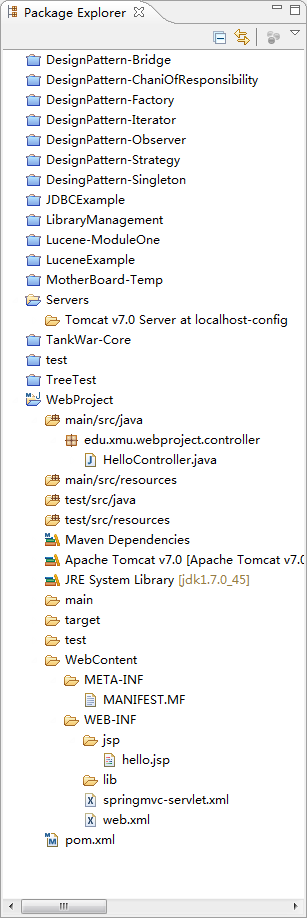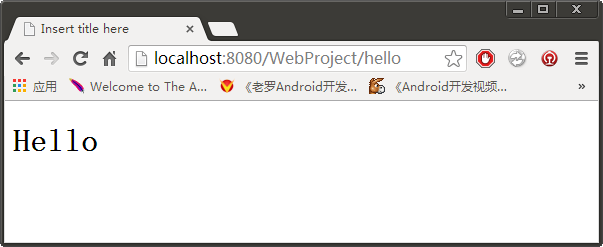Outline:
1) Annotation Based Url Mapping Config
2) Pass Value from View to Controller
3) Pass Value from Controller to View
HandlerMapping
1) SimpleUrlHandlerMapping (Not often used)
<beans ...>
<bean class="org.springframework.web.servlet.handler.SimpleUrlHandlerMapping">
<property name="mappings">
<value>
/index.htm=welcomeController
/welcome.htm=welcomeController
/main.htm=welcomeController
/home.htm=welcomeController
</value>
</property>
</bean>
<bean id="welcomeController"
class="com.mkyong.common.controller.WelcomeController" />
</beans>
2) ControllerBeanNameHandlerMapping (Not often userd)
<?xml version="1.0" encoding="UTF-8"?>
<beans xmlns="http://www.springframework.org/schema/beans"
xmlns:xsi="http://www.w3.org/2001/XMLSchema-instance" xmlns:context="http://www.springframework.org/schema/context"
xmlns:mvc="http://www.springframework.org/schema/mvc"
xsi:schemaLocation="
http://www.springframework.org/schema/beans
http://www.springframework.org/schema/beans/spring-beans.xsd
http://www.springframework.org/schema/context
http://www.springframework.org/schema/context/spring-context.xsd
http://www.springframework.org/schema/mvc
http://www.springframework.org/schema/context/spring-mvc.xsd">
<!-- Handler Mapping -->
<bean
class="org.springframework.web.servlet.mvc.support.ControllerBeanNameHandlerMapping" />
<bean name="/welcome.html" class="edu.xmu.webproject.controller.WelcomeController"></bean>
</beans>
3) DefaultAnnotationHandlerMapping (Often used)
springmvc-servlet.xml
<?xml version="1.0" encoding="UTF-8"?>
<beans xmlns="http://www.springframework.org/schema/beans"
xmlns:mvc="http://www.springframework.org/schema/mvc" xmlns:xsi="http://www.w3.org/2001/XMLSchema-instance"
xmlns:context="http://www.springframework.org/schema/context"
xsi:schemaLocation="
http://www.springframework.org/schema/beans
http://www.springframework.org/schema/beans/spring-beans.xsd
http://www.springframework.org/schema/mvc
http://www.springframework.org/schema/mvc/spring-mvc.xsd
http://www.springframework.org/schema/context
http://www.springframework.org/schema/context/spring-context.xsd">
<context:component-scan base-package="edu.xmu.webproject.controller" />
<mvc:annotation-driven />
<!-- View Resolver for JSPs -->
<bean
class="org.springframework.web.servlet.view.InternalResourceViewResolver">
<property name="prefix" value="/WEB-INF/jsp/" />
<property name="suffix" value=".jsp" />
</bean>
</beans>
HelloController.java
package edu.xmu.webproject.controller;
import org.springframework.stereotype.Controller;
import org.springframework.web.bind.annotation.RequestMapping;
@Controller
public class HelloController
{
// RequestMapping represents which url mapped to this method
@RequestMapping({ "/hello", "/" })
public String hello()
{
return "hello";
}
}
hello.jsp
<%@ page language="java" contentType="text/html; charset=ISO-8859-1" pageEncoding="ISO-8859-1"%> <!DOCTYPE html PUBLIC "-//W3C//DTD HTML 4.01 Transitional//EN" "http://www.w3.org/TR/html4/loose.dtd"> <html> <head> <meta http-equiv="Content-Type" content="text/html; charset=ISO-8859-1"> <title>Insert title here</title> </head> <body> <h1>Hello</h1> </body> </html>
Final Test
2. Value Transportation
1) Pass Value from View to Controller
HelloController.java
package edu.xmu.webproject.controller;
import org.springframework.stereotype.Controller;
import org.springframework.web.bind.annotation.RequestMapping;
import org.springframework.web.bind.annotation.RequestParam;
@Controller
public class HelloController
{
// RequestMapping represents which url mapped to this method
@RequestMapping({ "/hello", "/" })
public String hello(@RequestParam("username") String userName)
{
System.out.println("username=" + userName);
return "hello";
}
}
Request Url
http://localhost:8080/WebProject/hello?username=davy
Console Output
username=davy
Request Url
http://localhost:8080/WebProject/hello
Got HTTP Stauts 400 Error. Bad request.
Why? Cause spring-mvc supports RESTFUL style, as long as we pass the params, RESTFUL style regards that as a part of URL.
2) A more simple way to pass value from View to Controller
HelloController.java
package edu.xmu.webproject.controller;
import org.springframework.stereotype.Controller;
import org.springframework.web.bind.annotation.RequestMapping;
@Controller
public class HelloController
{
// RequestMapping represents which url mapped to this method
@RequestMapping({ "/hello", "/" })
public String hello(String username)
{
System.out.println("username=" + username);
return "hello";
}
}
We removed the annotation "@RequestParam". That requires "username" be exactly the same with the request url's param key.
http://localhost:8080/WebProject/hello?username=davy # username=davy http://localhost:8080/WebProject/hello # username=null http://localhost:8080/WebProject/hello?userName=davy # username=null
3) Pass value from Controller to View
HelloController.java
package edu.xmu.webproject.controller;
import java.util.Map;
import org.springframework.stereotype.Controller;
import org.springframework.web.bind.annotation.RequestMapping;
@Controller
public class HelloController
{
// RequestMapping represents which url mapped to this method
@RequestMapping({ "/hello", "/" })
public String hello(String username, Map<String, Object> context)
{
System.out.println("username=" + username);
context.put("username", username);
return "hello";
}
}
hello.jsp
<%@ page language="java" contentType="text/html; charset=ISO-8859-1"
pageEncoding="ISO-8859-1"%>
<!DOCTYPE html PUBLIC "-//W3C//DTD HTML 4.01 Transitional//EN" "http://www.w3.org/TR/html4/loose.dtd">
<html>
<head>
<meta http-equiv="Content-Type" content="text/html; charset=ISO-8859-1">
<title>Insert title here</title>
</head>
<body>
<h1>Hello ${username}</h1>
</body>
</html>
Request Url
http://localhost:8080/WebProject/hello?username=davy
Output
Hello davy
4) A recommanded way to pass value from Controller to View
HelloController.java
package edu.xmu.webproject.controller;
import org.springframework.stereotype.Controller;
import org.springframework.ui.Model;
import org.springframework.web.bind.annotation.RequestMapping;
@Controller
public class HelloController
{
// RequestMapping represents which url mapped to this method
@RequestMapping({ "/hello", "/" })
public String hello(String username, Model model)
{
System.out.println("username=" + username);
model.addAttribute("username", username);
// The key is the type of the value, first letter lowercase
model.addAttribute(username);
return "hello";
}
}
hello.jsp
<%@ page language="java" contentType="text/html; charset=ISO-8859-1"
pageEncoding="ISO-8859-1"%>
<!DOCTYPE html PUBLIC "-//W3C//DTD HTML 4.01 Transitional//EN" "http://www.w3.org/TR/html4/loose.dtd">
<html>
<head>
<meta http-equiv="Content-Type" content="text/html; charset=ISO-8859-1">
<title>Insert title here</title>
</head>
<body>
<h1>Hello ${username} & ${string}</h1>
</body>
</html>
3. Model Driven Value Transportation
What if we need to pass 20 params to the controller?
How should we encapsulate these params into Object/Model?
Example below shows how to use model driven to pass model between view and controller.
1) User.java
package edu.xmu.webproject.bean;
public class User
{
private String username;
private String password;
private String nickname;
private String email;
public User(String username, String password, String nickname, String email)
{
super();
this.username = username;
this.password = password;
this.nickname = nickname;
this.email = email;
}
public User()
{
super();
}
public String getNickname()
{
return nickname;
}
public void setNickname(String nickname)
{
this.nickname = nickname;
}
public String getEmail()
{
return email;
}
public void setEmail(String email)
{
this.email = email;
}
public String getUsername()
{
return username;
}
public void setUsername(String username)
{
this.username = username;
}
public String getPassword()
{
return password;
}
public void setPassword(String password)
{
this.password = password;
}
}
2) UserController.java
package edu.xmu.webproject.controller;
import java.util.HashMap;
import java.util.Map;
import org.springframework.stereotype.Controller;
import org.springframework.ui.Model;
import org.springframework.web.bind.annotation.RequestMapping;
import org.springframework.web.bind.annotation.RequestMethod;
import edu.xmu.webproject.bean.User;
@Controller
@RequestMapping("/user")
public class UserController
{
private Map<String, User> userMap = new HashMap<String, User>();
public UserController()
{
userMap.put("davy", new User("Davy", "Jones", "davy", "[email protected]"));
userMap.put("calypso", new User("Calypso", "Jones", "carl",
"[email protected]"));
userMap.put("obama", new User("Obama", "Barack", "obama",
"[email protected]"));
userMap.put("tom", new User("Tom", "Cruize", "tom", "[email protected]"));
}
@RequestMapping(value = "/users", method = RequestMethod.GET)
public String listAllUsers(Model model)
{
System.out.println("List all users");
model.addAttribute("userMap", userMap);
return "/user/list";
}
// This method nevigate us to the page for add user
@RequestMapping(value = "/add", method = RequestMethod.GET)
public String addUser(Model model)
{
System.out.println("Nevigate to add user page");
// For the benefit of open model driven
model.addAttribute("user", new User());
return "/user/add";
}
// This method handle the request for add user
@RequestMapping(value = "/add", method = RequestMethod.POST)
public String addUser(User user)
{
System.out.println("Add user");
String username = user.getUsername();
userMap.put(username, user);
return "redirect:/user/users";
}
}
3) list.jsp
<%@ page language="java" contentType="text/html; charset=ISO-8859-1"
pageEncoding="ISO-8859-1"%>
<%@ taglib prefix="c" uri="http://java.sun.com/jsp/jstl/core"%>
<!DOCTYPE html PUBLIC "-//W3C//DTD HTML 4.01 Transitional//EN" "http://www.w3.org/TR/html4/loose.dtd">
<html>
<head>
<meta http-equiv="Content-Type" content="text/html; charset=ISO-8859-1">
<title>Insert title here</title>
</head>
<body>
<a href="add">Add User</a>
<br />
<c:forEach items="${userMap}" var="user">
---------${user.value.username}
---------${user.value.password}
---------${user.value.nickname}
---------${user.value.email}
<br />
</c:forEach>
</body>
</html>
4) add.jsp
<%@ page language="java" contentType="text/html; charset=ISO-8859-1" pageEncoding="ISO-8859-1"%> <%@ taglib uri="http://www.springframework.org/tags/form" prefix="sf"%> <!DOCTYPE html PUBLIC "-//W3C//DTD HTML 4.01 Transitional//EN" "http://www.w3.org/TR/html4/loose.dtd"> <html> <head> <meta http-equiv="Content-Type" content="text/html; charset=ISO-8859-1"> <title>Insert title here</title> </head> <body> <!-- Here we didn't assign an action for this form. --> <!-- By default, the form will be submitted to current path '/user/add' --> <!-- With the method POST --> <sf:form method="post" modelAttribute="user"> username: <sf:input path="username" /> <sf:errors path="username"/> <br /> password: <sf:input path="password" /><sf:errors path="password"/> <br /> nickname: <sf:input path="nickname" /> <br /> email: <sf:input path="email" /><sf:errors path="email"/> <br /> <input type="submit" value="Submit" /> </sf:form> </body> </html>
5) springmvc-servlet.xml
<?xml version="1.0" encoding="UTF-8"?>
<beans xmlns="http://www.springframework.org/schema/beans"
xmlns:mvc="http://www.springframework.org/schema/mvc" xmlns:xsi="http://www.w3.org/2001/XMLSchema-instance"
xmlns:context="http://www.springframework.org/schema/context"
xsi:schemaLocation="
http://www.springframework.org/schema/beans
http://www.springframework.org/schema/beans/spring-beans.xsd
http://www.springframework.org/schema/mvc
http://www.springframework.org/schema/mvc/spring-mvc.xsd
http://www.springframework.org/schema/context
http://www.springframework.org/schema/context/spring-context.xsd">
<context:component-scan base-package="edu.xmu.webproject.controller" />
<mvc:annotation-driven />
<!-- View Resolver for JSPs -->
<bean
class="org.springframework.web.servlet.view.InternalResourceViewResolver">
<property name="viewClass"
value="org.springframework.web.servlet.view.JstlView"></property>
<property name="prefix" value="/WEB-INF/" />
<property name="suffix" value=".jsp" />
</bean>
</beans>
6) web.xml
<?xml version="1.0" encoding="UTF-8"?> <web-app xmlns:xsi="http://www.w3.org/2001/XMLSchema-instance" xmlns="http://java.sun.com/xml/ns/javaee" xmlns:web="http://java.sun.com/xml/ns/javaee/web-app_2_5.xsd" xsi:schemaLocation="http://java.sun.com/xml/ns/javaee http://java.sun.com/xml/ns/javaee/web-app_3_0.xsd" id="WebApp_ID" version="3.0"> <display-name>WebProject</display-name> <servlet> <servlet-name>springmvc</servlet-name> <servlet-class>org.springframework.web.servlet.DispatcherServlet</servlet-class> <load-on-startup>1</load-on-startup> </servlet> <servlet-mapping> <servlet-name>springmvc</servlet-name> <url-pattern>/</url-pattern> </servlet-mapping> </web-app>
7) pom.xml
<project xmlns="http://maven.apache.org/POM/4.0.0" xmlns:xsi="http://www.w3.org/2001/XMLSchema-instance"
xsi:schemaLocation="http://maven.apache.org/POM/4.0.0 http://maven.apache.org/xsd/maven-4.0.0.xsd">
<modelVersion>4.0.0</modelVersion>
<groupId>edu.xmu.web.WebProject</groupId>
<artifactId>WebProject-Core</artifactId>
<version>0.0.1-SNAPSHOT</version>
<packaging>war</packaging>
<properties>
<spring.version>3.0.5.RELEASE</spring.version>
</properties>
<dependencies>
<dependency>
<groupId>junit</groupId>
<artifactId>junit</artifactId>
<version>4.8.1</version>
<scope>test</scope>
</dependency>
<dependency>
<groupId>javax.servlet</groupId>
<artifactId>servlet-api</artifactId>
<version>2.5</version>
<scope>provided</scope>
</dependency>
<!-- Spring 3 dependencies -->
<dependency>
<groupId>org.springframework</groupId>
<artifactId>spring-core</artifactId>
<version>${spring.version}</version>
</dependency>
<dependency>
<groupId>org.springframework</groupId>
<artifactId>spring-web</artifactId>
<version>${spring.version}</version>
</dependency>
<dependency>
<groupId>org.springframework</groupId>
<artifactId>spring-webmvc</artifactId>
<version>${spring.version}</version>
</dependency>
<dependency>
<groupId>org.springframework</groupId>
<artifactId>spring-context</artifactId>
<version>${spring.version}</version>
</dependency>
<!-- JSTL -->
<dependency>
<groupId>jstl</groupId>
<artifactId>jstl</artifactId>
<version>1.2</version>
</dependency>
</dependencies>
<build>
<plugins>
<plugin>
<groupId>org.apache.maven.plugins</groupId>
<artifactId>maven-war-plugin</artifactId>
<version>2.1.1</version>
<configuration>
<webXml>WebContent\WEB-INF\web.xml</webXml>
</configuration>
</plugin>
</plugins>
</build>
</project>
8) Final Test
Model Driven Summary:
1) Model from Controller to View to display user info:
1> Store beans to model
@RequestMapping(value = "/users", method = RequestMethod.GET)
public String listAllUsers(Model model)
{
System.out.println("List all users");
model.addAttribute("userMap", userMap);
return "/user/list";
}
2> Use JSTL in JSP page in order to display model content
<!-- JSTL --> <dependency> <groupId>jstl</groupId> <artifactId>jstl</artifactId> <version>1.2</version> </dependency>
<%@ taglib prefix="c" uri="http://java.sun.com/jsp/jstl/core"%>
...
<c:forEach items="${userMap}" var="user">
---------${user.value.username}
---------${user.value.password}
---------${user.value.nickname}
---------${user.value.email}
<br />
</c:forEach>
2) Model from View to Controller to add user info:
1> Open model driven in controller, if we don't add User to model, then the view will not know the type of Model.
Exceptions below will occur:
十一月 09, 2013 8:29:48 下午 org.springframework.web.servlet.tags.RequestContextAwareTag doStartTag 严重: Neither BindingResult nor plain target object for bean name 'user' available as request attribute java.lang.IllegalStateException: Neither BindingResult nor plain target object for bean name 'user' available as request attribute
// First way to open model driven
// This method nevigate us to the page for add user
@RequestMapping(value = "/add", method = RequestMethod.GET)
public String addUser(Model model)
{
System.out.println("Nevigate to add user page");
// For the benefit of open model driven
model.addAttribute("user", new User());
return "/user/add";
}
// Second way to open model driven
// This method nevigate us to the page for add user
@RequestMapping(value = "/add", method = RequestMethod.GET)
public String addUser(@ModelAttribute("user") User user)
{
System.out.println("Nevigate to add user page");
return "/user/add";
}
<%@ taglib uri="http://www.springframework.org/tags/form" prefix="sf"%> ... <sf:form method="post" modelAttribute="user"> username: <sf:input path="username" /> <sf:errors path="username"/> <br /> password: <sf:input path="password" /><sf:errors path="password"/> <br /> nickname: <sf:input path="nickname" /> <br /> email: <sf:input path="email" /><sf:errors path="email"/> <br /> <input type="submit" value="Submit" /> </sf:form>
// This method handle the request for add user
@RequestMapping(value = "/add", method = RequestMethod.POST)
public String addUser(User user)
{
System.out.println("Add user");
String username = user.getUsername();
userMap.put(username, user);
return "redirect:/user/users";
}
Reference Links:
1) http://www.mkyong.com/spring-mvc/configure-the-handler-mapping-priority-in-spring-mvc/
2) http://docs.spring.io/spring/docs/3.0.x/reference/mvc.html




